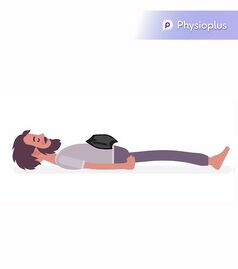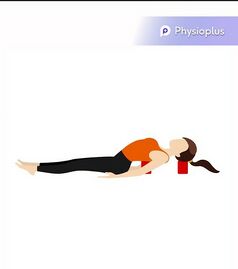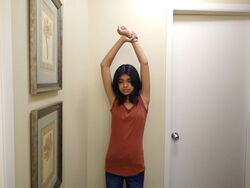Diaphragm Rehabilitation
Top Contributors - Carin Hunter, Jess Bell, Kim Jackson and Ewa Jaraczewska
Surgical Diagnoses[edit | edit source]
- Congenital diaphragmatic hernia: Involves one or more of a person's abdominal organs (stomach, spleen, liver, intestines) move upward into the chest through a defect in the diaphragm. Congenital hernias are considered a medical emergency and require prompt surgery[1]
- Acquired Diaphragmatic Hernia (ADH): Penetrating (GSW/stabbing) or blunt injury (falls/ MVA). Penetrating injuries are the more common cause than the blunt injuries as a cause of the diaphragmatic rupture.[2]
Diaphragm atrophy secondary to MV[edit | edit source]
- Disuse atrophy is a resultant of decreased protein synthesis[3], increased proteolysis[4] or combination of both factors.
- Oxidative stress starts setting in within 6 hours of CMV which is linked to diaphragmatic dysfunction and weakness[5]. This phenomenon is also noticed in skeletal muscles however it needs longer time to set in.[6]
- Note : A study conducted by Grosu and Lee in 2017 concluded there was no relationship between changes in diaphragm thickness and extubation outcome[7], however another study conducted by Ewan et al reached a conclusion that, diaphragm atrophy developing during mechanical ventilation strongly impacts clinical outcomes. Targeting an inspiratory effort level similar to that of healthy subjects at rest might accelerate liberation from ventilation.
- Manual Evaluation Diaphragm[8] (MED) scale, the only evaluation scale in the world to generate a value for the mobility of the main respiratory muscle
Techniques to strengthen the diaphragm (26)[edit | edit source]
- Sandbag breathing
- Deep Chest Breathing
- Bellow’s Breath
- Intercostal Stretching Breath
- Focused Diaphragmatic Breath
- Diaphragm stretches
- TA Activation
- Straw breathing
- Cat-Cow pose
1. Sandbag breathing:[edit | edit source]
Supine. The spine is not bent to either side.
Establish a flow of relaxed breathing, in three steps:
- Feel the breath flowing out and in, repeatedly.
- Soften the abdomen and feel it rise as you inhale and fall as you exhale.
- Let the breath flow without pause between the breaths.
2. Deep Chest Breathing[edit | edit source]
Deep chest breathing requires two yoga blocks. You need to sit on the floor and place the blocks behind you – one in a flat position and the other at the medium position. You need to lay your shoulder blades on the flat block and your head on the other. Then relax your arms out to each side with palms faced upwards. Next, you need to stretch your legs out in front of you. Inhale deeply and allow your chest to completely rise. On the exhale, allow your stomach to fall first, then your diaphragm, then your lungs and finally your chest. Repeat this exercise nine times with a regular breath in-between each repetition. Deep chest breathing tones both the diaphragm and the intercostal muscles.
3. Bellow’s Breath[edit | edit source]
Bellow’s breath is a detoxifying breathing exercise which is good for the diaphragm muscle. To carry out this exercise you need to be in a seated position. Once comfortable, you need to inhale naturally through your nose. On the exhale you need to snap your stomach muscles in, forcing the exhalation. While in a seated position, inhale naturally through your nose. On the exhale, snap your stomach muscles in, forcing the exhalation. Repeat this breathing pattern for 30 seconds, gradually increasing the pace.
4. Intercostal Stretching Breath[edit | edit source]
To perform an intercostal stretching breath, come to a standing position and stretch both of your arms over the head. Inhale deeply and on the exhale, stretch your arms to the right, stretching your intercostal muscles on the left side of your body. Inhale and come back to the centre; on the next exhale, stretch your arms to the left, feeling your right intercostal muscles being stretched. Repeat two more times on each side.
Resisted external intercoastal muscle activation , increasing the transverse diameter
5. Focused Diaphragmatic Breath[edit | edit source]
To perform focused diaphragmatic breath, it is helpful to understand exactly where your diaphragm is. Take your fingers and place them on the bottom of your sternum. Take a few breaths and feel your diaphragm move. To perform this breathing exercise, tense your stomach muscles and keep your fingers on your diaphragm. Inhale and exhale several times, focusing on the diaphragm’s movement. This exercise can help increase awareness of and tone the diaphragm.
6. Diaphragm stretches: [edit | edit source]
To perform the diaphragm stretch[9] you need to be in 90/90 hip knee flexion in supine. Place the heels of your hands on your thighs, close to the hip creases. Breathe calmly through your nose a few times. After a deep inhale and full exhale, push your hands into your thighs and think of doing an inhale without actually letting air in. Suck belly in and expand the ribs to create a vacuum. Try making small movements to bring the spine and pelvis into flexion, extension, and lateral shifts to produce more stretch to different parts of the diaphragm. Breathe normally for a cycle or two repeating 5 times
7. Transversus Abdominus Activation:[edit | edit source]
For a Transversus Abdominus activation[9] you should lie on your back with your knees bent, place your feet hip-width apart and a block lengthwise between your thighs. With your pelvis and low back neutral, place your fingertips on your lower abdomen, just between your front hip bones (ASIS). On an exhale, let your belly button drop, engage the pelvic floor, and squeeze the block. Feel for the transverse abdominis (TVA) popping up under your fingertips. Maintaining the neutral curve of your spine as your belly drops is key here. On your inhale, relax and soften the belly. Do a few rounds to find the deep activation of your core.
- Repeat the exercise above and at the end of your exhale lift both your feet an inch off the floor. Stay for an inhale before lightly placing your feet back down.
8. Straw breathing[edit | edit source]
Holding a straw between your lips, inhale through your nose and exhale through the straw. Breathing out through a long straw will automatically make your exhalation longer than the inhalation
9. Cat-Cow pose(27)[edit | edit source]
Breathe in through your nose and out through your mouth. As you breathe out, round your back even further and tuck your chin toward your chest. Keep rounding as you blow all the air out of the lungs. Pause at the end of your exhale for five seconds, holding the rounded position. Then, breathe in through your nose.
8. 28 D stretches in Standiing[edit | edit source]
Stand in a comfortable position. You will begin by stretching the left side of the diaphragm. These fibers are mostly located between the 12th rib and the central tendon along the inside of the rib cage, which is called the zone of opposition. Lift your left arm over your head, and place your right hand on your lower ribs on the left side
- As you exhale, laterally flex your spine to the right (figure 1.9). Two factors are causing the diaphragm to lengthen as you perform this movement—the fact that you are exhaling, and the increase in distance between the 12th rib and the top of the diaphragm.
- Inhale as you return to the upright position. Repeat the movement for five breath cycles. Exhale as you move to the right; inhale as you return to the upright position.
- To increase the stretch, gently push down on the left lower ribs (7-12) with your right hand.
- Repeat the movement on opposite side for five cycles of breath. As you move to the left, exhale; as you return to the upright position, inhale.
- Finally, reach up with both arms and clasp your hands. Laterally flex your spine to the right and left (figure 1.10). During lateral flexion, exhale; when you return to center, inhale. Move to the right and left four times
- To finish the exercise, reach up with both arms and clasp your hands. Laterally flex your spine to the right and left (figure 1.10). During lateral flexion, exhale; when you return to center, inhale. Move to the right and left four times
Breathing Techniques[edit | edit source]
Diaphragm disorders:
https://www.ncbi.nlm.nih.gov/books/NBK470172/
Valsalva maneuver:
https://www.siditalia.it/images/Pstras_L.pdf
paradoxical breathing :[edit | edit source]
Pranayama, breathing techniques[edit | edit source]
Ujjayi breathing :[edit | edit source]
Bellows breathing :[edit | edit source]
MET diaphragm release[edit | edit source]
MFR for diaphragm[edit | edit source]
References[edit | edit source]
- ↑ Petrosyan M, Shah AA, Chahine AA, Guzzetta PC, Sandler AD, Kane TD. Congenital paraesophageal hernia: Contemporary results and outcomes of laparoscopic approach to repair in symptomatic infants and children. Journal of pediatric surgery. 2019 Jul 1;54(7):1346-50.
- ↑ Newbury A, Dorfman JD, Lo HS. Imaging and management of thoracic trauma. InSeminars in Ultrasound, CT and MRI 2018 Aug 1 (Vol. 39, No. 4, pp. 347-354). WB Saunders.
- ↑ Ku Z, Yang JI, Menon VA, Thomason DB. Decreased polysomal HSP-70 may slow polypeptide elongation during skeletal muscle atrophy. American Journal of Physiology-Cell Physiology. 1995 Jun 1;268(6):C1369-74.
- ↑ Bodine SC, Latres E, Baumhueter S, Lai VK, Nunez L, Clarke BA, Poueymirou WT, Panaro FJ, Na E, Dharmarajan K, Pan ZQ. Identification of ubiquitin ligases required for skeletal muscle atrophy. Science. 2001 Nov 23;294(5547):1704-8.
- ↑ Zergeroglu MA, McKenzie MJ, Shanely RA, Van Gammeren D, DeRuisseau KC, Powers SK. Mechanical ventilation-induced oxidative stress in the diaphragm. Journal of applied physiology. 2003 Sep;95(3):1116-24.
- ↑ Kondo HI, Miura MI, Nakagaki IK, Sasaki SA, Itokawa YO. Trace element movement and oxidative stress in skeletal muscle atrophied by immobilization. American Journal of Physiology-Endocrinology And Metabolism. 1992 May 1;262(5):E583-90.
- ↑ Grosu HB, Ost DE, Im Lee Y, Song J, Li L, Eden E, Rose K. Diaphragm muscle thinning in subjects receiving mechanical ventilation and its effect on extubation. Respiratory care. 2017 Jul 1;62(7):904-11.
- ↑ Bordoni B, Morabito B. The Diaphragm Muscle Manual Evaluation Scale. Cureus. 2019 Apr;11(4).
- ↑ 9.0 9.1 Rathore M, Trivedi S, Abraham J, Sinha MB. Anatomical correlation of core muscle activation in different yogic postures. International Journal of Yoga. 2017 May;10(2):59.











